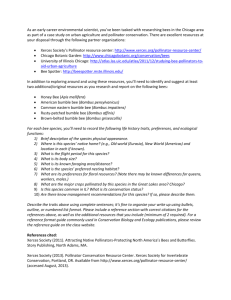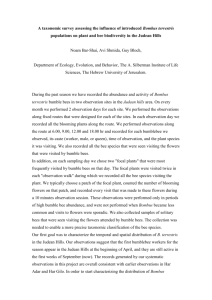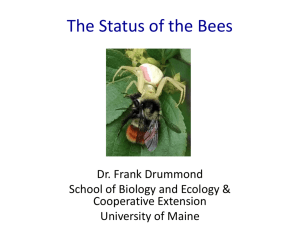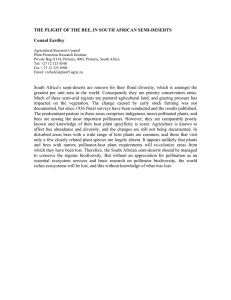SPECIES FACT SHEET Scientific Name: Common Name:
advertisement
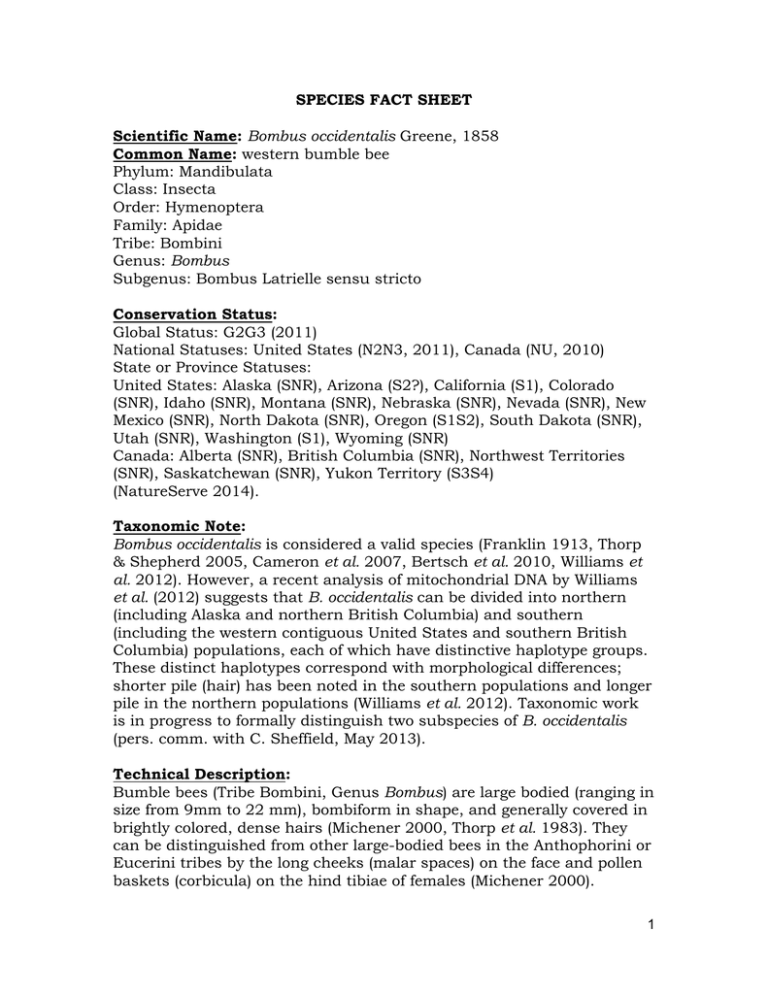
SPECIES FACT SHEET Scientific Name: Bombus occidentalis Greene, 1858 Common Name: western bumble bee Phylum: Mandibulata Class: Insecta Order: Hymenoptera Family: Apidae Tribe: Bombini Genus: Bombus Subgenus: Bombus Latrielle sensu stricto Conservation Status: Global Status: G2G3 (2011) National Statuses: United States (N2N3, 2011), Canada (NU, 2010) State or Province Statuses: United States: Alaska (SNR), Arizona (S2?), California (S1), Colorado (SNR), Idaho (SNR), Montana (SNR), Nebraska (SNR), Nevada (SNR), New Mexico (SNR), North Dakota (SNR), Oregon (S1S2), South Dakota (SNR), Utah (SNR), Washington (S1), Wyoming (SNR) Canada: Alberta (SNR), British Columbia (SNR), Northwest Territories (SNR), Saskatchewan (SNR), Yukon Territory (S3S4) (NatureServe 2014). Taxonomic Note: Bombus occidentalis is considered a valid species (Franklin 1913, Thorp & Shepherd 2005, Cameron et al. 2007, Bertsch et al. 2010, Williams et al. 2012). However, a recent analysis of mitochondrial DNA by Williams et al. (2012) suggests that B. occidentalis can be divided into northern (including Alaska and northern British Columbia) and southern (including the western contiguous United States and southern British Columbia) populations, each of which have distinctive haplotype groups. These distinct haplotypes correspond with morphological differences; shorter pile (hair) has been noted in the southern populations and longer pile in the northern populations (Williams et al. 2012). Taxonomic work is in progress to formally distinguish two subspecies of B. occidentalis (pers. comm. with C. Sheffield, May 2013). Technical Description: Bumble bees (Tribe Bombini, Genus Bombus) are large bodied (ranging in size from 9mm to 22 mm), bombiform in shape, and generally covered in brightly colored, dense hairs (Michener 2000, Thorp et al. 1983). They can be distinguished from other large-bodied bees in the Anthophorini or Eucerini tribes by the long cheeks (malar spaces) on the face and pollen baskets (corbicula) on the hind tibiae of females (Michener 2000). 1 Carpenter bees in the tribe Xylocopini are also large-bodied and sometimes mistaken for bumble bees, although most carpenter bees have shiny abdomens and lack the dense abdominal hairs that bumble bees possess. Carpenter bees are rare in the Pacific Northwest; records from Oregon are largely confined to Klamath, Jackson, Josephine, and Wallowa counties, and they do not occur in Washington (Discover Life 2013). Bombus occidentalis is most easily distinguished from other Bombus species based on hair coloration. Note, however, that coloration in this species can be highly variable (Thorp et al. 1983), and a total of twelve female and twelve male color forms have been described (Franklin 1913). The color forms of B. occidentalis that are most likely to be encountered in Oregon and Washington have bright white coloration on the posterior end of the abdomen (R. Thorp pers. comm. May 2013); this character is unusual and obvious. The nominate form, which is one of the primary color forms found in Oregon and Washington (Xerces Society 2012), is illustrated in Attachment 4 and described by Evans et al. 2008 as follows: Queens and Workers: Bombus occidentalis queens and workers are similar in coloration. The queen is 17 to 19 mm in length, 9 to 10 mm in breadth. The worker is 9 to 14 mm in length, 5 to 7 mm in breadth. Their hair is entirely black on the head. Their hair is yellow on the front part of the thorax. The first through the basal section of the fourth abdominal segments have black hair. The apex of the fourth abdominal segment as well as segments five and six are whitish. The hair on their legs is black. Males: The male is 13 to 17 mm in length, 6 to 8 mm in breadth. The hair on the head is pale yellowish on the front of the face. The top of the head has pale yellowish hairs medially, with some black hairs, especially laterally. The hair on the front of the thorax is pale yellowish. The hair on the first to third abdominal segments is black. The basal part of the fourth abdominal segment is black, with the remainder, as well as segments five to seven, whitish. Koch et al. (2012) describe additional useful characters of all color forms of female B. occidentalis as follows: Face round. Mid leg basitarsus with the distal posterior corner rounded. Cheek length slightly shorter than width… On the side of the thorax, the lower anterior surface with 2 predominantly black hair, sometimes with yellow intermixed, corbicular fringes red. Hair length medium and even. Life History: Bumble bees are primitively eusocial insects that live in colonies made up of one queen, female workers, and, near the end of the season, reproductive members of the colony (new queens, or gynes, and males). New colonies are initiated by solitary queens, generally in the early spring. This process includes locating a suitable nest site; collecting pollen and nectar from flowers; building a wax structure to store nectar; forming a mass of pollen to lay eggs on; and building a wax structure to enclose the eggs and pollen. Bombus occidentalis, like most other species of bumble bees, primarily nests underground in abandoned rodent burrows or other cavities (Hobbs 1968, MacFarlane et al. 1994, Plath 1922, Thorp et al. 1983). Thus, B. occidentalis nesting sites may be limited by rodent abundance (Evans et al. 2008). Once the colony has been initiated by the queen and the first brood of female workers have grown, pupated, and emerged as adults, the female workers take over all duties of foraging for pollen and nectar, colony defense, and feeding larvae. The queen’s only responsibility at this point is to lay eggs. Bombus occidentalis colonies can contain as many as 1,685 workers and produce up to 360 new queens; this colony size is considered large relative to many other species of bumble bees (MacFarlane et al. 1994). Bumble bees, including B. occidentalis, are generalist foragers and have been reported visiting a wide variety of flowering plants. Bombus occidentalis has a short tongue, and thus is best suited to forage at open flowers with short corollas. In addition to foraging at the open face of flowers, B. occidentalis is also known to engage in a behavior called ‘nectar robbing’ in which a hole is chewed in the base of flowers with long corollas to obtain nectar without actually facilitating plant pollination. According to Thorp et al. (1983), the flight period for B. occidentalis queens in California is from early February to late November, peaking in late June and late September. The flight period for workers and males in California is from early April to early November; worker abundance peaks in early August, and male abundance peaks in early September (Thorp et al. 1983). In the late summer or fall, depending on the bumble bee species and elevation, colonies produce reproductive individuals (males and gynes), which leave the colony and mate. As winter approaches, the old queen, workers, and males die, while the gynes continue to forage for nectar, 3 then find a suitable location (hibernacula), usually burrowed a few centimeters underground, in which to spend the winter. The newly mated queens store sperm until they initiate a colony the following spring. Bumble bees may be more vulnerable to extinction than other species due to their unique system of reproduction (haplodiploidy with single locus complementary sex determination) (Zayed & Packer 2005, reviewed in Zayed 2009). Range, Distribution, and Abundance: Bombus occidentalis was historically broadly distributed across the west coast of North America from Alaska to central California, east through Alberta and western South Dakota, and south to Arizona and New Mexico (Williams et al. In Press). A rangewide analysis including more than 73,000 records of eight bumble bee species suggests that B. occidentalis has undergone a 28% range decline between recent (20072009) and historic (1900-1999) time periods (Cameron et al. 2011a). A separate, unpublished analysis comparing the current (2002-2012) and historic (1805-2001) ranges of B. occidentalis (using a database of more than 200,000 records of 43 species of North American bumble bees developed by Williams et al. In Press) suggests that this species has declined from 50% of its historic range; the southern subspecies (which is currently being described by C. Sheffield) has been lost from 62% of its historic range (Hatfield et al., unpublished data). The relative abundance of B. occidentalis has declined by 75% (Hatfield et al., unpublished data). Declines were found to be most significant at the edges of this species’ range (Hatfield et al., unpublished data). In Oregon and Washington, B. occidentalis populations are currently largely restricted to high elevation sites (Xerces Society 2012), and the species is no longer found in the western portions of either state where it was once common (Cameron et al. 2011a). BLM/Forest Service Land: In Washington, Bombus occidentalis has been Documented on Colville, Gifford-Pinchot, Mt. Baker-Snoqualmie, Okanogan-Wenatchee, and Olympic National Forests. It is Suspected on Umatilla National Forest and Spokane District BLM land, based on close proximity to known records. In Oregon, this species has been Documented on Deschutes, Fremont-Winema, Malheur, Mt. Hood, Ochoco, Rogue River-Siskiyou, Siuslaw, Umatilla, Umpqua, Willamette, and Wallow-Whitman National Forests, and BLM land in the Burns, Lakeview and Medford Districts. Given the relatively recent range contraction for this species, it is unknown what the current “Documented” status is for many of these field units, as many of the documented sites are considered historic. The Oregon Biodiversity Information Center (ORBIC, 2013) lists documented 4 sites for this species as occurring in Baker, Clackamas, Coos(?), Douglas, Gilliam, Hood River, Jackson, Jefferson, Josephine, Klamath, Lake, Lane, Lincoln, Polk(?), and Union Counties, although a recent compilation of records in support of this fact sheet also includes Deschutes County (Xerces Society 2012). Abundance: Since most records available for B. occidentalis are from incidental observations or museum specimen records rather than from quantitative studies, population estimates at specific sites are largely unavailable. Furthermore, using field estimates of abundance to understand bumble bee population stability can be problematic because observations of multiple individuals may represent a single reproductive unit (because of the colonial life history of bumble bees). Relative abundance can be a useful metric to evaluate population trends in bumble bee species. In a database of more than 200,000 records of North American bumble bees, B. occidentalis specimens comprised approximately 1.6% of all North American bumble bee records from 2002-2012, whereas B. occidentalis comprised approximately 6.3% of all records from 1801-2002 (Hatfield et al., unpublished data). Habitat Associations: Bumble bees inhabit a wide variety of natural, agricultural, urban, and rural habitats, although species richness tends to peak in flower-rich meadows of forests and subalpine zones (Goulson 2010). While B. occidentalis was historically known throughout Oregon and Washington, it is now largely confined to high elevation sites and areas east of the Cascade Crest (Williams et al. In Press, Cameron et al. 2011, Xerces Society 2012). Like other bumble bees, Bombus occidentalis has three basic habitat requirements: suitable nesting sites for the colonies, nectar and pollen from floral resources available throughout the duration of the colony period (spring, summer and fall), and suitable overwintering sites for the queens. Nest Sites: Reports of B. occidentalis nests are primarily in underground cavities such as old squirrel or other animal nests and in open west-southwest slopes bordered by trees, although a few nests have been reported from above-ground locations such as in logs among railroad ties (Hobbs 1968, MacFarlane et al. 1994, Plath 1922, Thorp et al. 1983). Availability of nests sites for B. occidentalis may depend on rodent abundance (Evans et al. 2008). Nest tunnels have been reported to be up to 2.1 m long for this 5 species and the nests may be lined with grass or bird feathers (MacFarlane et al. 1994). Floral Resources: Bumble bees require plants that bloom and provide adequate nectar and pollen throughout the colony’s life cycle, which is from early February to late November for B. occidentalis (although the actual dates likely vary by elevation). The amount of pollen available to foragers directly affects the number of new queens that a bumble bee colony can produce, and since queens are the only type of bumble bees that can form new colonies, pollen availability directly affects the future bumble bee population size (Burns 2004). Early spring and late fall are often periods with lower floral resources; the presence of flowering plants at these critical times is essential. Bombus occidentalis is a generalist forager and has been reported to visit a wide variety of flowering plants in Oregon and Washington. The plant genera most commonly associated with B. occidentalis observations or collections from Oregon and Washington include: Trifolium (20 observations), Cirsium (12), Rubus (7), Solidago (6), Epilobium (5), Spiraea (5), Tilia (5), Cicuta (4), Heracleum (3), and Plantago (3) (Williams et al. In Press). Similarly, in an analysis largely based on records from California, Thorp et al. (1983) reports that B. occidentalis records are primarily associated with plants in the Leguminosae (=Fabaceae), Compositae (=Asteraceae), Rhamnaceae, and Rosaceae families. Note that these floral associations do not necessarily represent B. occidentalis’ preference for these plants over other flowering plants, but rather may represent the abundance of these flowers in the landscape. Overwintering Sites: Very little is known about the hibernacula, or overwintering sites, utilized by B. occidentalis, although Hobbs (1968) reported B. occidentalis hibernacula that were two inches deep in a “steep west slope of the mound of earth.” The closely related B. terrestris reportedly hibernates beneath trees (Sladen 1912 in Hobbs 1968). Threats: The primary threats to B. occidentalis at the sites where it currently exists in Oregon and Washington include: pathogens from commercial bumble bees and other sources, impacts from reduced genetic diversity, and habitat alterations including conifer encroachment (resulting from fire suppression), grazing, and logging. Other threats include pesticide use, fire, agricultural intensification, urban development and climate change. These threats are reviewed below. 6 In a rangewide study of eight bumble bee species, B. occidentalis and other declining species were associated with increased levels of the fungal pathogen Nosema bombi relative to species that were found to be stable (Cameron et al. 2011a). The hypothesis, developed by Dr. Robbin Thorp, that an exotic strain of N. bombi was introduced to North American bumble bees via the commercial bumble bee industry is still under investigation (pers. comm. with S. Cameron 2012), although the evidence to date strongly supports this hypothesis. Pathogens and parasites from other sources, such as RNA viruses from honey bee colonies (Singh et al. 2010), also threaten wild bumble bees. Since B. occidentalis has recently undergone a dramatic decline in range and relative abundance, reduced genetic diversity and other genetic factors make this species especially vulnerable to extinction (reviewed in Zayed 2009), and may lead to increased pathogen susceptibility (Altizer et al. 2003, Whitehorn et al. 2009). Recent research indicates that populations of B. occidentalis have lower genetic diversity compared to populations of co-occurring stable species (Cameron et al. 2011a; Lozier et al. 2011). Modifications to bumble bee habitat from over grazing by livestock can be particularly harmful to bumble bees (reviewed in Hatfield et al. 2012) by removing floral resources, especially during the mid-summer period when flowers may already be scarce. In addition, livestock may trample nesting and overwintering sites, or disrupt rodent populations, which can indirectly harm bumble bees. Indirect effects of logging (such as increased siltation in runoff) and recreation (such as off-road vehicle use) also have the potential to alter meadow ecosystems and disrupt B. occidentalis habitat. Additional habitat alterations, such as conifer encroachment resulting from fire suppression (Panzer 2002, Schultz & Crone 1998, Roland & Matter 2007), fire, agricultural intensification (Williams 1986, Carvell et al. 2006, Diekotter et al. 2006, Fitzpatrick et al. 2007, Kosior et al. 2007, and Goulson et al. 2008), urban development (Jha & Kremen 2012; Bhattacharya et al. 2003), and climate change (Memmott et al. 2007, Thomson 2010, Cameron et al. 2011b) may threaten B. occidentalis. Insecticides, which are designed to kill insects directly, and herbicides, which can remove floral resources, both pose serious threats to bumble bees. Of particular concern are neonicotinoids, a class of systemic insecticides whose toxins are extraordinarily persistent and are expressed in the nectar and pollen of plants (and therefore are actively collected by bumble bees), and exert both lethal and sublethal effects on bumble bees (Whitehorn et al. 2012, reviewed in Hopwood et al. 2012). 7 Conservation Considerations: Inventory: Once very common in the western United States and western Canada, B. occidentalis has recently undergone a dramatic decline in abundance and distribution, and is no longer present across much of the historic range. In order to better understand the causes and extent of this species’ decline, as well as the conservation needs of remaining populations, additional comprehensive surveys of this species at historic and potential sites are needed throughout Oregon and Washington (see map in Attachment 3). Research: The aforementioned taxonomic work to describe two subspecies of B. occidentalis will have important conservation implications, since the northern subspecies, occurring primarily in Alaska and parts of British Columbia, appears to be abundant and stable, whereas the southern subspecies has undergone a dramatic decline. Once the subspecies are described, the southern subspecies will be considered more at risk than it was previously. This work is currently in progress (pers. comm. with C. Sheffield 2013). Management: Protect known and potential sites from practices, such as livestock grazing, and threats such as conifer encroachment, that can interfere with the habitat requirements of this species (availability of nectar and pollen throughout the colony season and availability of underground nest sites and hibernacula). Prepared by: Sarina Jepsen, Xerces Society for Invertebrate Conservation; Map and land ownership analysis by Sarah Foltz Jordan, Xerces Society for Invertebrate Conservation Date: May 2013 Edited by: Sarah Foltz Jordan, Xerces Society for Invertebrate Conservation Date: May 2013 Final Edits: Rob Huff, FS/BLM Date: February 2014 8 ATTACHMENTS: (1) References (2) List of pertinent or knowledgeable contacts (3) Map of species distribution (4) Illustration and photographs of species (5) Bombus survey protocol, including specifics for this species ATTACHMENT 1: References Altizer, S., D. Harvell, and E. Friedle. 2003. Rapid evolutionary dynamics and disease threats to biodiversity. Trends in Ecology & Evolution 18:589–596. Bertsch, A., Hrab’e de Angelis, M. & Przemeck, G.K.H. 2010. A phylogenetic framework for the North American bumblebee species of the subgenus Bombus sensu stricto (Bombus affinis, B. franklini, B. moderatus, B. occidentalis & B. terricola) based on mitochondrial DNA markers. Beitr¨age zur Entomologie 60:229–242. Bhattacharya, M., R. B. Primack, and J. Gerwein. 2003. Are roads and railroads barriers to bumblebee movement in a temperate suburban conservation area? Biological Conservation 109:37–45. Burns, I. 2004. Social development and conflict in the North American bumblebee Bombus impatiens Cresson. U of MN. Ph.D. Thesis. Cameron, Sydney. 2012. Professor, University of Illinois at ChampaignUrbana, IL. Personal communication with Sarina Jepsen, Xerces Society. Cameron S. A., H. M. Hines, and P. H. Williams. 2007. A comprehensive phylogeny of the bumble bees (Bombus). Biological Journal of the Linnean Society 91:161-188. Cameron, S. A., J. D. Lozier, J. P. Strange, J. B. Koch, N. Cordes, L. F. Solter, and T. L. Griswold. 2011a. Patterns of widespread decline in North American bumble bees. Proceedings of the National Academy of Sciences 108:662–667. Cameron, S., S. Jepsen, E. Spevak, J. Strange, M. Vaughan, J. Engler, and O. Byers [Eds.]. 2011b. North American Bumble Bee Species Conservation Planning Workshop Final Report. Available at: http://www.xerces.org/stlouis-iucn-bumblebee-conservation/. 9 Carvell, C., D. B. Roy, S. M. Smart, R. F. Pywell, C. D. Preston, and D. Goulson. 2006. Declines in forage availability for bumblebees at a national scale. Biological Conservation 132:481–489. Diekötter, T., K. Walther-Hellwig, M. Conradi, M. Suter, and R. Frankl. 2006. Effects of landscape elements on the distribution of the rare bumblebee species Bombus muscorum in an agricultural landscape. Arthropod Diversity and Conservation 15: 57-68. Discover Life. 2013. Xylocopa page. Available at: http://www.discoverlife.org/20/q. Accessed 13 May 2013. Evans, E., R. W. Thorp, S. Jepsen, and S. H. Black. 2008. Status review of three formerly common species of bumble bee in the Subgenus Bombus. Available at http://www.xerces.org/wpcontent/uploads/2009/03/xerces_2008_bombus_status_review.pdf. Fitzpatrick, Ã., T. E. Murray, R. J. Paxton, and M. J. F. Brown. 2007. Building on IUCN Regional Red Lists to Produce Lists of Species of Conservation Priority: a Model with Irish Bees. Conservation Biology 21: 1324–1332. Franklin, H. J. 1913. The Bombidae of the New World. Transactions of the American Entomological Society 38: 177-486. Goulson, D. 2010. Bumblebees: Behavior, Ecology, and Conservation. Oxford University Press. 317 pages. Goulson, D., G. C. Lye, and B. Darvill. 2008. Decline and conservation of bumble bees. Annu. Rev. Entomol. 53:191–208. Hatfield, R., S. Jepsen, E. Mader, S. H. Black, and M. Shepherd. 2012. Conserving Bumble Bees: Guidelines for Creating and Managing Habitat for America’s Declining Pollinators. The Xerces Society for Invertebrate Conservation. Available at http://www.xerces.org/bumblebees/guidelines. Hobbs, G. A. 1968. Ecology of species of Bombus Latr. (Hymenoptera: Apidae) in southern Alberta. VI. Subgenus Bombus, Canadian Entomologist 100: 156-164. 10 Hopwood J., M. Vaughan, M. Shepherd, E. Mader, and S. H. Black. 2012. Are Neocicotinoids Killing Bees? A review of research into the effects of neonicotinoid insecticides on bees, with recommendation for action. Tech. rep., The Xerces Society. http://www.xerces.org/neonicotinoids-and-bees/. Jha, S., and C. Kremen. 2013. Resource diversity and landscape-level homogeneity drive native bee foraging. Proceedings of the National Academy of Sciences 110:555–558. Koch, J. B., J. P. Strange, and P. H. Williams. 2012. Bumble Bees of the Western United States. USDA Forest Service and the Pollinator Partnership. Available at: http://www.fs.fed.us/wildflowers/pollinators/documents/BumbleBeeGu ide2012.pdf. Kosior, A., W. Celary, P. Olejniczak, J. Fijal, W. Krol, W. Solarz, and P. Plonka. 2007. The decline of the bumble bees and cuckoo bees (Hymenoptera: Apidae: Bombini) of Western and Central Europe. Oryx 41:79. Lozier, J. D., J. P. Strange, I. J. Stewart, and S. A. Cameron. 2011. Patterns of range-wide genetic variation in six North American bumble bee (Apidae: Bombus) species. Molecular Ecology. Retrieved February 1, 2013, from http://onlinelibrary.wiley.com/doi/10.1111/j.1365294X.2011.05314.x/full. Macfarlane R. P., K. D. Patten, L. A. Royce, B. K. W. Wyatt, and D. F. Mayer. 1994. Management potential of sixteen North American bumble bee species. Melanderia 50:1-12. Memmott J., P. G. Craze, N. M. Waser, and M. V. Price. 2007. Global warming and the disruption of plant-pollinator interactions. Ecology Letters 10:710-717. Michener, C. D. 2000. The Bees of the World. John Hopkins University Press. 913 pages. NatureServe 2013. “Bombus occidentalis.” NatureServe Explorer: An online encyclopedia of life [web application]. Feb. 2009. Version 7.1. NatureServe, Arlington, Virginia. Available at: http://www.natureserve.org/explorer/ (Accessed 30 May 2013).Plath O. E. 1922. Notes on the nesting habits of several North American bumblebees. Psyche 29(5-6):189-202. 11 ORBIC (Oregon Biodiversity Center). 2013 Rare, Threatened, and Endangered Species of Oregon. July 2013. Available at http://orbic.pdx.edu/rte-species.html (Accessed 6 February 2014). Panzer, R. 2002. Compatibility of prescribed burning with the conservation of insects in small, isolated prairie reserves. Conservation Biology 16:1296–1307. Roland, J., and S. F. Matter. 2007. Encroaching forests decouple alpine butterfly population dynamics. Proceedings of the National Academy of Sciences 104:13702–13704. Schultz, C. B., and E. E. Crone. 2008. Note: using ecological theory to advance butterfly conservation. Israel Journal of Ecology and Evolution 54:63–68. Sheffield, Cory. 2013. Curator, Royal Saskatchewan Museum, Saskatchewan, Canada. Personal Communication with Sarina Jepsen, The Xerces Society. Singh R., A. L. Levitt, E. G. Rajotte, E. C. Holmes, N. Ostiguy, D. vanEngelsdorp, W. I. Lipkin, C. W. dePamphilis, A. L. Toth, and D. L. Cox-Foster. 2010. RNA Viruses in Hymenopteran Pollinators: Evidence of Inter-Taxa Virus Transmission via Pollen and Potential Impact on NonApis Hymenopteran Species. PLoS ONE 5(12): e14357. doi:10.1371/journal.pone.0014357. Thomson, J. D. 2010. Flowering phenology, fruiting success and progressive deterioration of pollination in an early-flowering geophyte. Philosophical Transactions of the Royal Society B: Biological Sciences 365:3187–3199. Thorp, Robbin. 2013. Professor emeritus, University of California, Davis. Personal communication with Sarina Jepsen, Xerces Society. Thorp, R. W., D. S Horning and L. L. Dunning. 1983. Bumble bees and cuckoo bumble bees of California (Hymenoptera: Apidae). Bulletin of the California Insect Survey 23: viii. Thorp, R. W., and M. D. Shepherd. 2005. Profile: Subgenus Bombus. Red list of pollinator insects of North America. Available online: Whitehorn, P. R., M. C. Tinsley, M. J. F. Brown, B. Darvill, and D. Goulson. 2009. Impacts of inbreeding on bumblebee colony fitness under field conditions. BMC Evolutionary Biology 9:152. 12 Whitehorn P., S. O'Connor, F. Wackers, and D. Goulson. 2012. Neonicotinoid pesticide reduces bumble bee colony growth and queen production. Science, 336(6079):351-2. doi: 10.1126/science.1215025. Williams, P. H. 1986. Environmental change and the distributions of British bumble bees (Bombus Latr.). Bee world 67:50–61. Williams P. H., M. J. F. Brown, J. C. Carolan, J. An, D. Goulson, A. Murat Ayetkin, L. R. Best, A. M. Byvaltsev, B. Cederberg, R. Dawson, J. Huang, M. Ito, A. Monfared, R. H. Raina, P. Schmid-Hempel, C. S. Sheffield, P. Sima, and Z. Xie. 2012. Unveiling cryptic species of the bumblebee subgenus Bombus s. str. Worldwide with COI barcodes (Hymenoptera: Apidae). Systematics and Biodiversity, http://dx.doi.org/10.1080/14772000.2012.664574 Williams, P. H., R. W. Thorp, L. L. Richardson, and S. Colla. In Press. Guide to the Bumble Bees of North America. Princeton University Press. Xerces Society. 2012. Database of records from Bumble Bee Citizen Monitoring Project (2008-2012). Maintained by Rich Hatfield, Xerces Society. Zayed, A. 2009. Bee genetics and conservation. Apidologie 40:237–262. Zayed, A., and L. Packer. 2005. Complementary sex determination substantially increases extinction proneness of haplodiploid populations. Proceedings of the National Academy of Sciences of the United States of America 102:10742–10746. ATTACHMENT 2: List of pertinent or knowledgeable contacts Robbin Thorp, University of California, Davis James Strange, USDA ARS Logan Bee Lab Paul Williams, Natural History Museum, London Michael Otterstatter, Health Canada Cory Sheffield, Royal Saskatchewan Museum James Thomson, University of Toronto Sarina Jepsen, Xerces Society Rich Hatfield, Xerces Society Jeff Lozier, University of Alabama 13 ATTACHMENT 3: Map of species distribution Records of Bombus occidentalis in Oregon and Washington, relative to Forest Service and BLM lands. 14 ATTACHMENT 4: Illustration and photographs of species B. occidentalis (female) worker, nominate color form. Although twelve color forms for females of this species have been described (Franklin 1913), the color form illustrated above is representative of B. occidentalis that occur in Oregon and Washington. Both the nominate form and another color form that occurs in Oregon, Washington, and nearby areas are represented in the photographs, below. Illustration by Elaine Evans, The Xerces Society. Used with permission. Bombus occidentalis, nominate color form, adult female, dorsal view, from Scott Lake, Willamette National Forest, Oregon, September 2012. Photograph by Rich Hatfield, The Xerces Society. Used with Permission. 15 Bombus occidentalis, adult female, side view. Photograph taken in Johnson’s Landing, British Columbia by Gail Spitler, May 2010. ATTACHMENT 5: Bombus survey protocol, including specifics for this species Taxonomic group: Bombus Where: Bumble bees inhabit a wide variety of natural, agricultural, urban, and rural habitats, although species richness tends to peak in flower-rich meadows of forests and subalpine zones (Goulson 2010). Bumble bees are generalist pollinators that visit a wide variety of plants. In California, Thorp et al. (1983) report that the top four plant families with the most records of bumble bee visitation are: 1) Compositae (=Asteraceae), 2) Leguminosae (=Fabaceae), 3) Labiatae (=Lamiaceae), and 4) Ericaceae. In general, bumble bee surveys should target flower-rich meadows with blooming plants that bumble bees are known to frequent. Note, however, that the floral associations of bumble bees are complicated by a variety 16 of factors, including bumble bee species size, tongue length, specific floral preference, pollen and nectar availability, flower species abundance within the landscape, and bumble bee species phenology (Thorp et al. 1983). For species-specific floral associations, see the section at the end of this protocol. When: Adult bumble bees are best surveyed in mid- to late summer, during the peak flight period for worker bumble bees. Targeting the period when adult worker bumble bees are most abundant reduces the possibility of capturing queens (which would effectively eliminate an entire bumble bee colony), and increases one’s chances of encountering rare species. Because phenology varies both by species and elevation, survey timing for specific sites can be determined by reviewing the phenology of historic records for the target species at nearby sites. In addition, an understanding of the peak availability of floral resources at specific sites may be helpful in identifying the most appropriate survey window. Sampling should occur on warm, calm, and sunny days, since bee foraging activity is reduced in cold, windy and rainy conditions (LeBuhn et al. 2003). How: Although pan-trapping is a method commonly recommended for sampling native bees, use of aerial sweep nets appears to be a more appropriate method to collect bumble bees and other large-bodied native bees (Cane et al. 2000, Roulston et al. 2007). Bumble bees nectaring at flowers typically remain in the same area for several minutes, and can be easily collected using an aerial sweep net. It is useful to use a net with a mesh that is light enough to see the specimen through the net. When stalking individuals at flowers, approach slowly from behind. When chasing, swing from behind and be prepared to pursue the insect. After capture, quickly flip the top of the net bag over to close the mouth and prevent the bumble bee from escaping. Once netted, most insects tend to fly upward, so hold the mouth of the net downward and reach in from below when retrieving the bumble bee. Take care to not get stung; female bumble bees will sting when disturbed. To remove the specimen from the net by hand, insert a jar into the net in order to get the specimen into the jar without direct handling. Some bumble bee species can be readily identified by macroscopic characters, so high quality photographs may provide sufficient evidence of species occurrences at a site, and those of lesser quality will at least be valuable in directing further study to an area. Use a camera with a good zoom or macrolens and focus on the aspects of the body that are the most critical to species determination (i.e., hair coloration on the head, thorax, and abdomen; corbicula – or lack thereof – on hind legs; and face 17 shape). Multiple photos of different angles of the specimen will aid in identification. It is helpful to use a square-shaped jar when taking photos of a live specimen, as the square jars do not distort images to the degree that rounded jars do. In addition, the bumble bee in the jar can be placed on ice for approximately 3-5 minutes; this will reduce the bee’s activity level, which will facilitate obtaining a photograph of the appropriate characters. If collection of voucher specimens is necessary, the captured bumble bee should be placed into a jar with an ethanolsoaked tissue at the bottom to kill it. Or, it can be collected in an empty jar, then frozen within ~8 hours of collecting it. After 2-3 days in the freezer, the specimen can be removed and pinned. If specimens are intended to be used for DNA analysis, they can be stored in 95% ethanol instead of freezing and pinning them. The Very Handy Bee Manual (Droege et al. 2010) provides detailed instructions on collecting, preparing, and pinning bumble bees for long term preservation and/or deposition in formal collections. Timed surveys within a measured area can provide a useful way to quantify survey effort. If two surveyors are present, it is recommended that the survey area be divided in half beforehand. Each person can walk through half of the survey area for a given amount of time (e.g. 15 minutes), then switch areas with the other surveyor for that same amount of time, in order to reduce surveyor bias (LeBuhn et al. 2003). A stopwatch should be used by both parties, and paused while netting and identifying bumble bees and recording data. Standardized methods for evaluating species richness and population trends of bumble bees (and other native bees) are available in LeBuhn et al. (2003), and include detailed recommendations regarding plot location, size, and description; vegetation analysis; data entry and management; how frequently to sample; and specific methods for using both aerial sweep nets and pan traps. Collection labels include the following information: country, state, county, site, detailed locality information (including geographical coordinates, elevation, mileage from named location), date, time of day, floral host, and collector (LeBuhn et al. 2003). Complete determination labels include the species name, caste (queen, female worker, or male), determiner name, and date determined. While researchers are visiting sites and collecting specimens, detailed habitat data should also be acquired, including vegetation types, vegetation canopy cover, suspected or documented host plant species, landscape contours (including direction and angle of slopes), and degree of human impact. Photographs of habitat are also a good supplement to 18 collected specimens and, if taken, should be cataloged and referred to on the insect labels. Identification: To identify a bumble bee to species, it is first necessary to determine whether the bee is male or female. There are three castes of bumble bees: workers (female), queens (female) and drones (male). Queens and workers generally have similar color patterns, although queens are larger. Males tend to have different color patterns and other features. Males have thirteen antennal segments, whereas females have twelve antennal segments. In some species, males have longer hair and larger eyes than females. In addition, males possess seven abdominal segments, whereas females have only six, and male bumble bees lack corbicula. Bumble bees in the subgenus Psithyrus are parasites that invade the nests of other bumble bee species, kill or subdue the queen, and use the workers to rear their own offspring. Psithyrus contain only queen and male castes (no female workers), and do not have corbicula. In addition to hair color patterns and hair length, other features such as cheek (malar) length, corbicular hair characteristics, location of simple eyes (ocelli) relative to the top of the compound eyes, and male genitalia structure can be useful in identifying bumble bees. A current field guide to bumble bees (and key to female bumble bees) of the western United States is available by Koch et al. (2012). A key to male and female bumble bees of the western United States can be found in Stephen (1957) and a key to male and female bumble bees of California is provided in Thorp et al. (1983). Species-specific Survey Details: Bombus occidentalis Where Although this species historically occurred throughout western North America, its range has dramatically declined in recent years. In Oregon and Washington, B. occidentalis was once widely distributed, but now appears to be primarily restricted to higher elevation sites east of the Cascade Crest (Xerces Society 2012, Cameron et al. 2011). Additional surveys at historic and potential sites on National Forests and BLM districts where B. occidentalis is suspected or documented are needed to identify this bee’s current distribution in Oregon and Washington. Meadows and grasslands with abundant floral resources are the appropriate habitat for this species. Bombus occidentalis is a generalist 19 forager and and has been reported to visit a wide variety of flowering plants in Oregon and Washington. The plant genera most commonly associated with B. occidentalis observations or collections from Oregon and Washington include: Trifolium (20 observations), Cirsium (12), Rubus (7), Solidago (6), Epilobium (5), Spiraea (5), Tilia (5), Cicuta (4), Heracleum (3), and Plantago (3) (Williams et al. In Press). Similarly, in an analysis largely based on records from California, Thorp et al. (1983) reports that B. occidentalis is primarily associated with plants in the Leguminosae (=Fabaceae), Compositae (=Asteraceae), Rhamnaceae, and Rosaceae families. Although B. occidentalis has a short tongue, and can therefore most easily access open flowers with short corollas, it does visit flowers with longer corollas to rob nectar (a behavior in which the bee chews a hole in the base of the corolla to obtain nectar without actually achieving pollination). Although meadows with flowers in the genera and families noted above may be targeted for surveys, it is important to note that these floral associations do not necessarily represent B. occidentalis’ preference for these plants over other flowering plants, but rather may represent the abundance of these flowers in the landscape. When: Surveys should target the peak flight period for female workers, which is in early August for B. occidentalis in California (Thorp et al. 1983) and mid-August for B. occidentalis in Utah (Koch et al. 2012). However, the peak flight period at a specific site will vary by elevation. The colony life cycle for B. occidentalis can begin as early as February and, in some cases, can last until late November. According to Thorp et al. (1983), the flight period for B. occidentalis queens in California ranges from early February to late November, peaking in late June and late September. The flight period for workers and males in California is from early April to early November; worker abundance peaks in early August, and male abundance peaks in early September (Thorp et al. 1983). Identification: In Oregon and Washington, this species is readily identified by the white hairs on the apex of the fourth abdominal segment, as well as on the fifth and sixth segments. Additional distinguishing features are available in Koch et al. (2012) and are provided in the ISSSSP Species Fact Sheet. References (Survey Protocol only): Cameron, S. A., J. D. Lozier, J. P. Strange, J. B. Koch, N. Cordes, L. F. Solter, and T. L. Griswold. 2011. Patterns of widespread decline in North American bumble bees. Proceedings of the National Academy of Sciences 108:662–667. 20 Cane, J. H., R. L. Minckley, and L. J. Kervin. 2000. Sampling bees (Hymenoptera: Apiformes) for pollinator community studies: pitfalls of pan-trapping. Journal of the Kansas Entomological Society 73:225–231. Droege, S., J. Green, T. Zarrillo, and L. Sellers. 2010. The very handy manual: how to catch and identify bees and manage a collection. Available at: http://bio2.elmira.edu/fieldbio/beemanual.pdf Goulson, D. 2010. Bumblebees: Behavior, Ecology, and Conservation. Oxford University Press. 317 pages. Koch, J. B., J. P. Strange, and P. H. Williams. 2012. Bumble Bees of the Western United States. USDA Forest Service and the Pollinator Partnership. Available at: http://www.fs.fed.us/wildflowers/pollinators/documents/BumbleBeeGu ide2012.pdf LeBuhn, G., T. Griswold, R. Minckley, S. Droege, T. Roulston, J. Cane, F. Parker, S. Buchmann, V. Tepedino, N. Williams, C. Kremen, and O. J. Messinger. 2003. A standardized method of monitoring bee populations— the Bee Inventory (BI) plot. Available at: http://online.sfsu.edu/~beeplot/pdfs/Bee%20Plot%202003.pdf Roulston, T. H., S. A. Smith, and A. L. Brewster. 2007. Short communication: a comparison of pan trap and intensive net sampling techniques for documenting a bee (Hymenoptera: Apiformes) fauna. Journal of the Kansas Entomological Society 80:179–181. Stephen, W. P. 1957. Bumble bees of western America. Oregon State University. 161 pages. Thorp, R. W., D. S Horning and L. L. Dunning. 1983. Bumble bees and cuckoo bumble bees of California (Hymenoptera: Apidae). Bulletin of the California Insect Survey 23: viii. Williams, P. H., R. W. Thorp, L. L. Richardson, and S. Colla. In Press. Guide to the Bumble Bees of North America. Princeton University Press. Xerces Society. 2012. Database of records from Bumble Bee Citizen Monitoring Project (2008-2012). Maintained by Rich Hatfield, Xerces Society. 21
